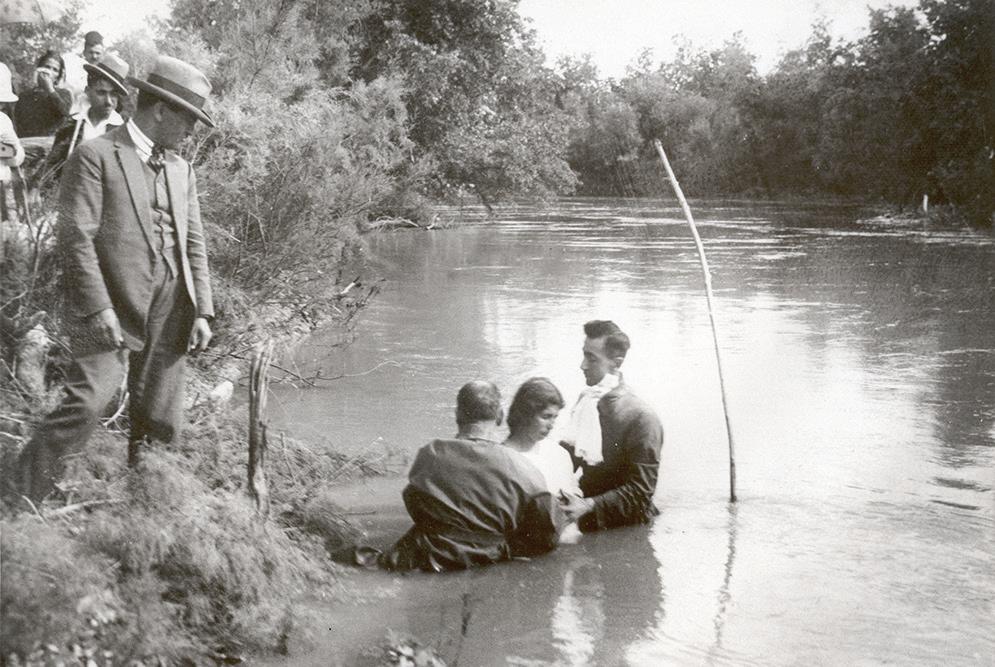
4 minute read
The Nazarene Synthesis
Nazarenes emerged from the holiness revival of the nineteenth century, children of the National Holiness Association (NHA). The NHA conducted holiness camp meetings and conventions starting in 1867 at Vineland, New Jersey. By 1900, it had spawned a network of state and local holiness associations across America. The story is well-told in Melvin E. Dieter’s The Holiness Revival of the Nineteenth Century (1980) and Charles Edwin Jones’ Perfectionist Persuasion (1974).
Early Nazarene leaders were active NHA members and preached in its camps, including C. W. Ruth, Phineas Bresee, and Edward F. Walker. Nazarenes have long called Christian holiness “our watchword and song.”
A common commitment to Christian holiness was not the only thing that knit the Nazarenes together. By 1900, North America was home to nearly 30 holiness groups, yet only five (and part of a sixth) were consolidated into the Pentecostal Church of the Nazarene by late 1908. So, why did other groups not join? Three elements in the Nazarene synthesis attracted those who united but excluded others.
The first was the acceptance of women in the ministry on an equal basis with men, a view held by all three uniting churches of 1907 and 1908. Bresee referred to a ministry inclusive of women as an “apostolic ministry” and believed that denominations that did not affirm women in ministry lacked this apostolic characteristic.
Nazarene contemporaries shared his view. A woman was ordained by the Nazarene forebears in New England in 1892, in the South in 1899, and on the Pacific coast in 1902. The gifts and graces of women in apostolic ministry were affirmed at the First and Second General Assemblies, where women were included in both classes of ordinands.
This feature excluded other groups. J. O. McClurkan refused to unite with Pentecostal Nazarenes over three issues, including this one. His Pentecostal Mission deployed women as evangelists and pastors, but he would not ordain them. His group only joined the Nazarenes after his death.
The second attracting and repelling issue was the Nazarene position on millennial theories. Interest in the subject was propelled by a series of prophecy conferences held across America in the late nineteenth century. The NHA would not allow speakers to preach on the Second Coming at its conferences and conventions because of the divisive potential. The NHA’s focus was on “the north star of holiness” without deviation into side issues.
The Nazarene synthesis gave space for members to hold differing millennial views. Bresee leaned toward premillennialism but considered the whole subject speculative and insisted on only broad affirmations concerning Christ’s return.(1) A. M. Hills, who taught theology at Pasadena College, was an ardent post-millennialist. His colleague, Olive Winchester, a New Testament scholar, was an amillennialist who believed that all elements of the Book of Revelation described events of the first and second centuries. The Nazarene watchword regarding Second Coming theory was “Liberty of Conscience.”
By contrast, other groups like the Pilgrim Holiness Church enshrined premillennialism as an article of faith, which would have excluded Hills, Winchester, and most Nazarenes in New England.
In the Nazarene synthesis, “Liberty of Conscience” also applied to baptismal theology and practice. Bresee’s primary practice was to baptize infants, doing so in various settings—including district assemblies—and he would immerse adults in Pacific Ocean surf. General superintendents Reynolds, Goodwin, Williams, and Chapman baptized dozens of infants at district assemblies in the 1920s and ‘30s.(2) One could be sprinkled, poured, or immersed. Chapman said Nazarenes insist only upon “some water by some mode.”(3)

Other holiness groups held exclusionary views. The Holiness Baptists of Arkansas would only unite with groups that practiced immersion. The New Testament Church of Christ also had an exclusive view, namely pouring as the scriptural mode of baptism, but its leaders were able to compromise and enter into covenant with those who preferred other modes.
So, the Nazarene synthesis had four elements: commitment to the Wesleyan-holiness theology of grace, including the grace of entire sanctification; women in ministry on an equal basis with men; and liberty of conscience on millennial theologies and baptismal practice.
These positions are all broad, not narrow. They have been part of our theological DNA, and every group joining the Nazarenes since 1908 has accepted this synthesis, which has served us well for a century and a quarter.
Dr. Stan Ingersol, Ph.D., is a church historian and former manager of the Nazarene Archives.
(1) E. A. Girvin, Phineas F. Bresee: A Prince in Israel (1916): 387-388.
(2) Extensive documentation of infant baptisms conducted at district assemblies is found in the text and the footnotes in Stan Ingersol, Past and Prospect: The Promise of Nazarene History (2013): 39-40.
(3) Herald of Holiness (Nov. 5, 1945): 8.








